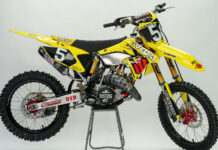When it comes to winning races Kawasaki have done pretty well for themselves it has to be said. Some could – and no doubt will – argue that it’s mostly down to the talent of Mitch Payton at Pro Circuit for not only building a bike that is so often the strongest in the MX2/Lites class but also his ability to keep finding rough diamonds and polishing them up into champions.
Here in Europe though Kawasaki haven’t been able to dominate the MX2 class like they do on the other side of the Atlantic. Only two men – fast Frenchies Mickael Maschio and Christophe Pourcel – have managed to break either KTM or Antonio Cairoli’s grip on the class over the last decade. Of course, when it comes to racing at that level the equipment is often far from what you can buy and a world away from what comes on a stock machine, contrary to the production rule.
However, the R&D that goes into professional racing is filtered down to the production bikes that we buy and this is clearly the case here. Kawasaki decided to introduce the fuel injection on the KX450F with great effect, making a good bike even better. They’ve now repeated that with the 2011 KX250F.
This year’s KX250F was a success as far as I’m concerned and like for all manufacturers there’s always a concern when you take something good and make big fundamental changes to try and improve it. I’ve been lucky enough to actually be involved with the testing and development for Kawasaki down the years as Ryan Voase and myself were involved with the introduction of the KX450F back in 2006 and I can say with confidence that the work that goes into the project is a relentless march. The durability test we had to endure was nearly enough to put me off riding a motocross bike forever – the bike passed the test with flying colours, the same couldn’t be said for us riders on the other hand!
I can honestly say that in the last decade alone due to technology moving so fast no manufacturers really make a bad motorcycle anymore so to get that little edge must be even harder for them all. I think more than ever it really is down to personal preference when choosing what bike to ride rather than going on technical information alone.
On the flight back from Italy after testing this bike, when I wasn’t feeling completely out of my nut and delirious from the humidity we rode in, I started to really assess the bike in my mind. The first thought that came into my head was ‘I wish that bloody kid would stop crying’ followed by ‘if I was an air steward I’d get annoyed that nobody watches my safety demonstration’ but after that I started to think about the fuel injection (FI). It really has revolutionised racing to the point that if you don’t have it you’re going to be left behind. So you better get with the programme.
Looking back on the day I realised I rode round the Gallarate track and never once did the bike bog, even in the humidity we were dealing with. It just eliminates any doubt in the throttle response and replaces it with confidence allowing you to tackle anything on the track. So the introduction of FI on the KX250F has definitely made it a bike that’s easier to ride – but is it as fast as this year’s model?
The answer? Yes! There’s an argument that by getting rid of the carburettor it might not be as quick and lose that bottom and mid-range grunt, especially if you take into consideration that they also had to make it quieter but they’ve managed to maintain the power. According to our teacher Mr Steve Guttridge in our presentation ‘lesson’ the new 250 will get you to the first corner, on average, 0.8 metres ahead of the 2010 model according to tests. Well, he’s bound to say that isn’t he?
Thing is, I think he’s right – teachers usually are aren’t they? I tried several starts on the new bike and although I never had a 2010 bike to compare them with I have to say the new bike did feel quicker but I think that was down to the throttle response off the snap and through the gear changes more than the motor itself. This thing is as sharp as a tack and with good reason.
Kawasakihaven’t just thrown the FI on and run with this year’s motor, they’ve worked on over-rev to go with the quick response and I tell you what, they’ve done it well. You really can rev the nadgers out of this bike (not that you need to) and it will take more abuse than a masochistic banker in a Soho cellar. The power keeps churning out right at the very top – it doesn’t fade out, it just revs and revs until you think ‘oh yeah, I better change gear now’! Of course, you shouldn’t wait to be reminded to change gear and there is an optimum point in the power curve to shift but if you’re a bit of a serial rev raver then you’re going to like this one.
No doubt about it, the power curve on this bike is a pleasure. Up the long drags on the hillside circuit I pulled tall gears, I let it scream in lower ones, rode with the throttle wide open, half closed, shut it off, opened it again – you name it, I tried to get the bike to labour but it just never did, not once. I was impressed with that. I then tried several laps without using the clutch and as the circuit started to dry and become more hard-packed with less loam to get good traction it certainly wasn’t a disadvantage. I mean why give the bike an explosive shot of power out of the turns when it doesn’t need one?
The FI will no doubt take all the plaudits but my impression is that the combined efforts of all the engine mods are equally responsible for this brilliant, fast and responsive power. The new piston, cylinder ratios and intake ducting all sync up and work as a team, unlike the England football squad. The piston has a new crown revised to suit chamfering in the squish area and that goes a long way in producing the over-rev, it also has an additional and reinforced rib and shorter skirt.
The intake camshaft has a revised sprocket and shaft arrangement to suit the FI with a valve lift from 8.7mm to 9.3 and stronger springs which also help it rev to the moon. There’s a new spark plug too which drops 1.4mm deeper in the chamber for even more oomph and improved efficiency and also compensates for the drop in mid-range torque that comes from a change to fuel injection. The cylinder height is reduced to 36.3mm from 36.5mm to suit the new piston and there’s a higher compression ratio which is now 13:5:1 compared to the previous 13:2:1. The header pipe is 30mm longer to suit the new motor and the noise police and it clearly works for both. It all works.
The new silencer has pinched cut outs in the chambers that direct the gases straight in the glass wool packing to keep the bike within the 115db regulations so effectively the bike is even ‘greener’ when it comes to keeping those environ-mentalists happy!
Kawasaki have fine-tuned the chassis to good effect and the bike definitely turns tighter than it did before due to the fork offset being reduced from 23.5 to 22.5mm. They’ve also set about giving it a little bit more lateral flex which gives better rear wheel traction and better tractability so you hit a line with more confidence and I have to say that’s what it felt like. I felt supremely confident on this bike and felt like I could put it anywhere I wanted on the track and that’s even taking into consideration my only real criticism of the 2011 KX250F – the forks.
I’ll sum them up in as little words as possible – ‘too soft’. There you go, it’s that’s simple. Kawasaki have made a major change in this department by switching to Showa’s separate function fork (SFF), the first mass production bike to do so and I think it’s a definite work in progress. It’s not a disaster by any stretch – it’s just a little disappointing that they aren’t quite in sync with what is otherwise a great bike.
If you haven’t got a clue what a separate function fork is let me explain. It’s pretty simple really – the clue is in the name. The left fork houses the damping assembly and the right fork the spring. According to Kawasaki and Showa this configuration offers smooth action, firm damping and easier, better adjustment and it does – the only problem is that from a starting point it’s a little too soft in my opinion. Kawasaki do offer a stiffer spring in the spares catalogue though and once I’d asked the technicians to put that solitary spring in the right fork the improvement was clear. It was a completely different bike.
So in actual fact it’s not a bad thing. By a simple spare part it then opens up this bike to a wide range of riders. Okay, if you’re a half-decent club rider or semi pro you’re going to have to buy a spring but in reality do you ever leave your bike in stock trim anyway? I’d guess not.
For the novices among you, I’ve got a feeling you’ll absolutely love the handling as much as the smooth, responsive power. No question the forks are plush and the movement is smooth thanks to the new system and Kashima coating on the inside of the fork legs and titanium coating on the sliders. Preload adjustment is simple – because the damper assembly is removed from the right fork it frees up space for a preload adjuster making it easier to set the preload and get the front height more in sync with the rear. On the more conventional fork that would mean stripping the forks and the use of specialist tools.
The new SFF also improves the balance and offsets the previous unbalanced weight of the brake caliper and disc on the left side. I know it’s not really a big thing but the adjusters look all factory too with the blue alumite finish. A little bit of bling is always good provided it’s not too much and the bike doesn’t look as colourful as a Christmas tree.
The rear shock has new damping settings to work with the front and I’m happy to say they aren’t as soft as the front end but there’s ample dual compression adjustability just like the forks. The rear shock linkage mounts are below the swingarm which offers better tuning. The bike tracks well at the rear and gives you good drive out of the corners when on the gas. Like I said, the only real negative was that the front wanted to push through while turning like you were rolling a tyre slightly but once we put the harder spring in that solved that problem. If we had more time and I wasn’t so bloody unfit I’ve got no doubt we’d have had the front end and rear working in harmony when it comes to balance by the end of the day.
Everything else about this bike I liked (well apart from the seat foam going soft really quickly). The ergonomics and riding position suited me great, I always felt I was sat in the right position and shifting my ever increasing bodyweight from front to rear was a breeze and the 2011 model seems to have a slimmer feel where the seat meets the rad shrouds. The brakes were razor sharp and now have a new petal design disc and the gearbox, clutch and controls were all smooth and precise.
All said and done the 2011 bike is an improvement on this year’s model but I couldn’t help but feel a little frustrated by the forks. They just took the edge of it a little. They were plush but I felt too many sharp edged bumps directly through my wrists and forearms and bottomed the bike out too many times in a lap. Other than that and few minor gripes like the seat foam and maybe going up one tooth sprocket on the rear to capitalise on that sharp response and over-rev available I’ve got to say I’d quite happily have a 2011 KX250F in the garage to pull out for a blast whenever possible.
It’s a fun bike to ride, it’s a fast bike to race. For a starting point for Mitch Payton to build yet another championship winning bike it’s a good one, that’s for sure. The same could be said for you…
Specification:
KX250F
Capacity: 249cc
Bore and stroke: 77mm x 53.6mm
Transmission: Five-speed
Fuel tank capacity: 7.2 litres
Front suspension: Showa USD SFF 47mm
Rear suspension: Uni-Trak
Front brake: 250mm disc
Rear brake: 240mm disc
Seat height: 945mm
Wheelbase: 1475mm
Ground clearance: 330mm
Dry weight: 105.7kg









